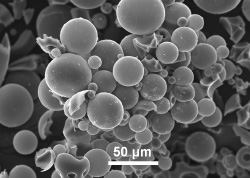News Story
Recycling Coal Byproducts Into Quality Concrete

A scanning electron microscopy image of synthetic fly ash.
Generated by the combustion of coal, fly ash is currently recycled in a variety of ways—including use in road construction, soil stabilization, paint, and building materials—to help keep some of the millions of tons of it produced each year out of landfills. One of its popular uses is as a substitute for a portion of the Portland cement required to make concrete. It is less expensive than Portland cement, and its glassy quality improves the flow of the concrete in its liquid state. However, concrete made with fly ash does not always perform as expected because the ash's particle size and chemical composition may vary widely depending on the coal and combustion conditions it came from. This inherent variability also makes it difficult to study and improve materials made with it.
The newly-funded project builds on the results of a 2009 proof-of-concept study in which Amde, Livingston and their colleagues created and characterized a synthetic glass fly ash that could serve as an accurate predictive model of behavior of fly ash in concrete. Because the synthetic material's particle size and composition can be controlled, it held the promise of enabling systematic studies of fly ash-based concrete for the first time. With the NSF's support, those studies can now take place.
"There is a lot of industry interest in this research because of its potential to transform the way that fly ash is used as a replacement for Portland cement," Livingston explains. "[The new grant] will enable us to investigate a wider range of fly ash compositions and conduct systematic studies of the variation of key factors. It will also use a wider range of analytical techniques, including nuclear magnetic resonance [imaging] and cluster analysis."
Published May 21, 2012









